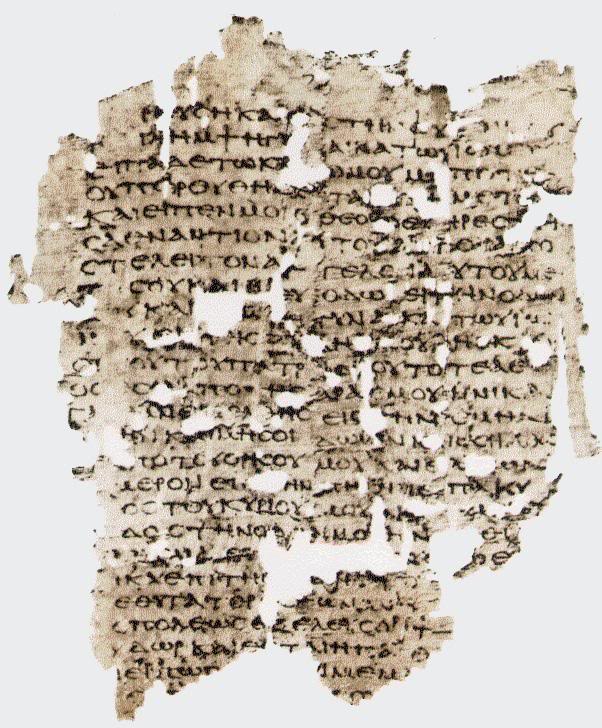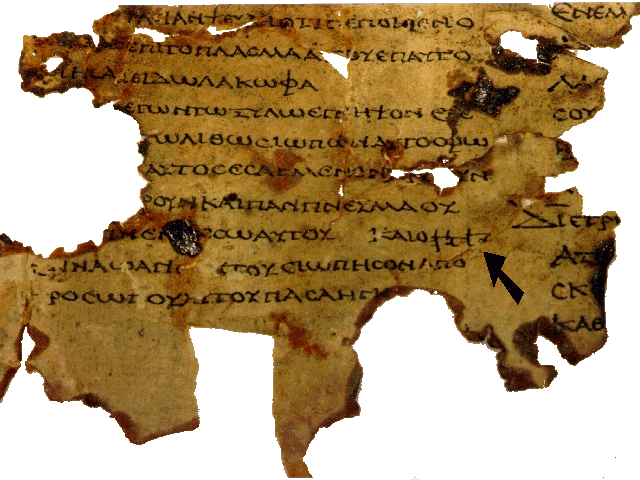|
Papyrus Oxyrhynchus 1007
Papyrus Oxyrhynchus 1007 (also known as LXXP.Oxy.VII.1007; P.Oxy. VII 1007; P.Lond.Lit. 199; TM 61956; LDAB 3113) is a fragment of a Septuagint manuscript (LXX) written in two columns on a parchment codex. The manuscript was discovered in Oxyrhynchus, modern El-Bahnasa, Egypt. The manuscript has been palaeographically dated to the 3rd century CE. Description The manuscript contains sections of the Book of Genesis (2:7-9, 2:16-19 recto; 2:23-3:1, 3:6-8 verso) written in 33 lines per column. This manuscript contains the Name of God "abbreviated by doubling the initial yod, written with in the shape of a z with a horizontal line through the middle, and carried unbroken through both characters zz." The fragment is difficult to identify as either Christian or Jewish, as on the barely legible recto side (in Gen 2:18) it contains the nomen sacrum ΘΣ (characteristic of Christian manuscripts) and the name of God written in Hebrew with a double Yodh (characteristic of Jewish manuscrip ... [...More Info...] [...Related Items...] OR: [Wikipedia] [Google] [Baidu] |
Papyrus Oxyrhynchus 656
Papyrus Oxyrhynchus 656 (abbreviated as P.Oxy.IV 656, VH 13, LBAD 3094, or Rahlfs 905) – is a Greek fragment of a Septuagint manuscript written on papyrus in codex form. This is a manuscript discovered at Oxyrhynchus, and it has been catalogued with number 656. Palaeographycally it is dated to late second century or early third century. Description The manuscript was written on papyrus, in codex form. The surviving fragments are four pieces of 24 cm by 20 cm. The fragments contain Genesis (14:21-23, 15:5-9, 19:32-20:11, 24:28-47, 27:32,33,40,41), written in Koine Greek. According to C. H. Roberts and van Haelst, it is almost certain to be Jewish. Treatment to the name of God Jason David BeDuhn, quoting Emanuel Tov wrote: Martin Rösel states that in this manuscript the first scribe left four gaps, three of which were filled by another with the word κύριος. Similarly, in Papyrus Rylands 458 a blank space remains, large enough for either κύριος or the Te ... [...More Info...] [...Related Items...] OR: [Wikipedia] [Google] [Baidu] |
3rd-century Biblical Manuscripts
The 3rd century was the period from 201 ( CCI) to 300 ( CCC) Anno Domini (AD) or Common Era (CE) in the Julian calendar.. In this century, the Roman Empire saw a Crisis of the Third Century, crisis, starting with the assassination of the Roman Emperor Severus Alexander in 235, plunging the empire into a period of economic troubles, barbarian incursions, political upheavals, civil wars, and the split of the Roman Empire through the Gallic Empire in the west and the Palmyrene Empire in the east, which all together threatened to destroy the Roman Empire in its entirety, but the reconquests of the seceded territories by Emperor Aurelian and the stabilization period under Emperor Diocletian due to the administrative strengthening of the empire caused an end to the crisis by 284. This crisis would also mark the beginning of Late Antiquity. In Persia, the Parthian Empire was succeeded by the Sassanid Empire in 224 after Ardashir I defeated and killed Artabanus V of Parthia, Artaban ... [...More Info...] [...Related Items...] OR: [Wikipedia] [Google] [Baidu] |
British Library
The British Library is the national library of the United Kingdom and is one of the largest libraries in the world. It is estimated to contain between 170 and 200 million items from many countries. As a legal deposit library, the British Library receives copies of all books produced in the United Kingdom and Ireland, including a significant proportion of overseas titles distributed in the UK. The Library is a non-departmental public body sponsored by the Department for Digital, Culture, Media and Sport. The British Library is a major research library, with items in many languages and in many formats, both print and digital: books, manuscripts, journals, newspapers, magazines, sound and music recordings, videos, play-scripts, patents, databases, maps, stamps, prints, drawings. The Library's collections include around 14 million books, along with substantial holdings of manuscripts and items dating as far back as 2000 BC. The library maintains a programme for content a ... [...More Info...] [...Related Items...] OR: [Wikipedia] [Google] [Baidu] |
Arthur Surridge Hunt
Arthur Surridge Hunt, FBA (1 March 1871 – 18 June 1934) was an English papyrologist. Hunt was born in Romford, Essex, England. Over the course of many years, Hunt, along with Bernard Grenfell, recovered many papyri from excavation sites in Egypt, including the Oxyrhynchus Papyri. He worked with Campbell Cowan Edgar on a translation of the Zenon Papyri from the original Greek Greek may refer to: Greece Anything of, from, or related to Greece, a country in Southern Europe: *Greeks, an ethnic group. *Greek language, a branch of the Indo-European language family. **Proto-Greek language, the assumed last common ancestor ... and Demotic. Publications *Grenfell, Bernard Pyne and Hunt, Arthur Surridge, ''Sayings of Our Lord from an early Greek Papyrus'' (Egypt Exploration Fund; 1897). *Grenfell, Bernard Pyne, Hunt, Arthur Surridge, and Hogarth, David George, Fayûm Towns and Their Papyri' (London 1900). *Grenfell, Bernard Pyne and Hunt, Arthur Surridge, eds., Hellenica ... [...More Info...] [...Related Items...] OR: [Wikipedia] [Google] [Baidu] |
Bernard Pyne Grenfell
Bernard Pyne Grenfell FBA (16 December 1869 – 18 May 1926) was an English scientist and Egyptologist. Life Grenfell was the son of John Granville Grenfell FGS and Alice Grenfell. He was born in Birmingham and brought up and educated at Clifton College in Bristol, where his father taught. He obtained a scholarship in 1888 and enrolled at The Queen's College, Oxford.Bell, H. (2004-09-23). Grenfell, Bernard Pyne (1869–1926), papyrologist. Oxford Dictionary of National Biography. Retrieved 18 Jan. 2018, Selink/ref> With his friend and colleague, Arthur Surridge Hunt, he took part in the archaeological dig of Oxyrhynchus and discovered many ancient manuscripts known as the Oxyrhynchus Papyri, including some of the oldest known copies of the New Testament and the Septuagint. Other notable finds are extensive, including previously unknown works by known classical authors. The majority of the find consists of thousands of documentary texts. Parabiblical material, such as copi ... [...More Info...] [...Related Items...] OR: [Wikipedia] [Google] [Baidu] |
London
London is the capital and List of urban areas in the United Kingdom, largest city of England and the United Kingdom, with a population of just under 9 million. It stands on the River Thames in south-east England at the head of a estuary down to the North Sea, and has been a major settlement for two millennia. The City of London, its ancient core and financial centre, was founded by the Roman Empire, Romans as ''Londinium'' and retains its medieval boundaries.See also: Independent city#National capitals, Independent city § National capitals The City of Westminster, to the west of the City of London, has for centuries hosted the national Government of the United Kingdom, government and Parliament of the United Kingdom, parliament. Since the 19th century, the name "London" has also referred to the metropolis around this core, historically split between the Counties of England, counties of Middlesex, Essex, Surrey, Kent, and Hertfordshire, which largely comprises Greater London ... [...More Info...] [...Related Items...] OR: [Wikipedia] [Google] [Baidu] |
British Library
The British Library is the national library of the United Kingdom and is one of the largest libraries in the world. It is estimated to contain between 170 and 200 million items from many countries. As a legal deposit library, the British Library receives copies of all books produced in the United Kingdom and Ireland, including a significant proportion of overseas titles distributed in the UK. The Library is a non-departmental public body sponsored by the Department for Digital, Culture, Media and Sport. The British Library is a major research library, with items in many languages and in many formats, both print and digital: books, manuscripts, journals, newspapers, magazines, sound and music recordings, videos, play-scripts, patents, databases, maps, stamps, prints, drawings. The Library's collections include around 14 million books, along with substantial holdings of manuscripts and items dating as far back as 2000 BC. The library maintains a programme for content a ... [...More Info...] [...Related Items...] OR: [Wikipedia] [Google] [Baidu] |
Larry W
Larry is a masculine given name in English, derived from Lawrence or Laurence. It can be a shortened form of those names. Larry may refer to the following: People Arts and entertainment * Larry D. Alexander, American artist/writer *Larry Boone, American country singer * Larry Collins, American musician, member of the rockabilly sibling duo The Collins Kids *Larry David (born 1947), Emmy-winning American actor, writer, comedian, producer and film director *Larry Emdur, Australian TV host * Larry Feign, American cartoonist working in Hong Kong *Larry Fine, of the Three Stooges *Larry Gates, American actor *Larry Gatlin, American country singer *Larry Gelbart (1928–2009), American screenwriter, playwright, director and author *Larry Graham, founder of American funk band Graham Central Station *Larry Hagman, American actor, best known for the TV series ''I Dream of Jeannie'' and ''Dallas'' * Larry Henley (1937–2014), American singer and songwriter, member of The Newbeats *Larry ... [...More Info...] [...Related Items...] OR: [Wikipedia] [Google] [Baidu] |
Yodh
Yodh (also spelled jodh, yod, or jod) is the tenth letter of the Semitic abjads, including Phoenician Yōd /𐤉, Hebrew Yōd , Aramaic Yod , Syriac Yōḏ ܝ, and Arabic . Its sound value is in all languages for which it is used; in many languages, it also serves as a long vowel, representing . The Phoenician letter gave rise to the Greek Iota (Ι), Latin I and J, Cyrillic І, Coptic (Ⲓ) and Gothic eis . The term yod is often used to refer to the speech sound , a palatal approximant, even in discussions of languages not written in Semitic abjads, as in phonological phenomena such as English " yod-dropping". Origins Yod originated from a hieroglyphic “hand”, or *yad. Hebrew Yod Hebrew spelling: colloquial ;The letter appears with or without a hook on different sans-serif fonts, for example: * Arial, DejaVu Sans, Arimo, Open Sans: * Tahoma, Alef, Heebo: Pronunciation In both Biblical and modern Hebrew, Yod represents a palatal approximant (). A ... [...More Info...] [...Related Items...] OR: [Wikipedia] [Google] [Baidu] |
Septuagint Manuscript
The Septuagint (LXX), the ancient (first centuries BC) Alexandrian translation of Jewish scriptures into Koine Greek exists in various manuscript versions. List of Septuagint manuscripts There are currently over 2000 classified manuscripts of the Septuagint. The first list of Septuagint manuscripts was presented by Holmes and Parsons. Their edition ends with a full list of manuscripts known to them set out in the Annexes. It enumerates 311 codes (marked with Roman numerals I-XIII and Arab 14-311), of which the codes are designated by their siglum I-XIII, 23, 27, 39, 43, 156, 188, 190, 258, 262. The codes marked with Roman numerals signify given letters from A to Z. The list of Septuagint manuscripts according to the classification of Alfred Rahlfs - a list of all known Septuagint manuscripts proposed by Alfred Rahlfs based on census of Holmes and Parsons. Division in classification by Rahlfs The table of Septuagint manuscripts is divided into ten parts: * Part I: A-Z ... [...More Info...] [...Related Items...] OR: [Wikipedia] [Google] [Baidu] |
Tetragrammaton
The Tetragrammaton (; ), or Tetragram, is the four-letter Hebrew theonym (transliterated as YHWH), the name of God in the Hebrew Bible. The four letters, written and read from right to left (in Hebrew), are '' yodh'', '' he'', '' waw'', and ''he''. The name may be derived from a verb that means "to be", "to exist", "to cause to become", or "to come to pass".Translation notes for While there is no consensus about the structure and etymology of the name, the form ''Yahweh'' is now accepted almost universally, though the vocalization '' Jehovah'' continues to have wide usage. The books of the Torah and the rest of the Hebrew Bible except Esther, Ecclesiastes, and (with a possible instance of the short form in verse 8:6) the Song of Songs contain this Hebrew name. Observant Jews and those who follow Talmudic Jewish traditions do not pronounce nor do they read aloud proposed transcription forms such as ''Yahweh'' or '' Yehovah''; instead they replace it with a different t ... [...More Info...] [...Related Items...] OR: [Wikipedia] [Google] [Baidu] |







